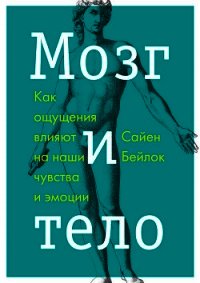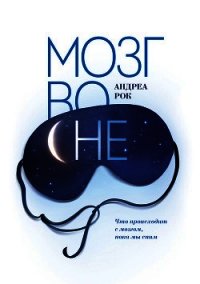Мозг рассказывает.Что делает нас людьми - Рамачандран Вилейанур С. (прочитать книгу txt) 📗
and imitation impairments in individuals with autism spectrum disorder. Brain and
Cognition,
64(3), 228-237.
Berrios, G. E., & Luque, R. (1995). Cotards syndrome. ЛсГй Psychiatrica
Scandinavica, 91(3), 185-188.
*Bickerton, D. (1994). Language and human behavior. Seattle: University
of Washington Press.
Bisiach, E., & Geminiani, G. (1991). Anosognosia related to hemiplegia and
hemianopia. In G. P. Prigatano and D. L. Schacter (Eds.), Awareness of deficit
after brain injury: Clinical and theoretical issues. Oxford: Oxford University
Press.
Blake, R., Palmeri, T. J., Marois, R., & Kim, C. Y. (2005). On the perceptual
reality of synesthetic color. In L. Robertson and N. Sagiv (Eds.), Synesthesia:
Perspectives from cognitive neuroscience (pp. 47-73). New York: Oxford
University Press. ‘Blackmore, S. (1999). The тете machine. Oxford: Oxford
University Press. Blakemore, S.-J., Bristow, D., Bird, G., Frith, C., & Ward, J.
(2005). Somatosensory activations during the observation of touch and a case of
vision-touch synaesthesia. Brain, 128,1571-1583.
‘Blakemore, S.-J., & Frith, U. (2005). The learning brain. Oxford, UK:
Blackwell Publishing.
Botvinick, М., & Cohen, J. (1998). Rubber hands “feel” touch that eyes see.
Nature, 391(6669),756.
Brang, D., Edwards, L., Ramachandran, V. S., & Coulson, S. (2008). Is the
sky 2? Contextual priming in grapheme-color synaesthesia. Psychological Science,
19(5), 421-428.
Brang, D., McGeoch, P., & Ramachandran, V. S. (2008). Apotemnophilia:
A neurological disorder. Neuroreport, 19(13), 1305-1306.
Brang, D., & Ramachandran, V. S. (2007a). Psychopharmacology of
synesthesia: The role of serotonin S2a receptor activation. Medical Hypotheses,
70(4), 903-904.
Brang, D., & Ramachandran, V. S. (2007b). Tactile textures evoke specific
emotions: A new form of synesthesia. Poster session presented at the 48th annual
meeting of the Psychonomic Society, Long Beach, CA.
Brang, D., & Ramachandran, V. S. (2008). Tactile emotion synesthesia.
Neurocase, 15(4), 390-399. Brang, D., & Ramachandran, V.S. (2010). Visual field
heterogeneity, laterality, and eidetic imagery in synesthesia. Neurocase, 16(2),
169-174.
Buccino, G., Vogt, S., Ritzl, A., Fink, G. R., Zilles, K., Freund, H. J., et al.
(2004). Neural circuits underlying imitation of hand actions: An event related
fMRI study. Neuron, 42,323-334.
Bufalari, I., Aprile, Т., Avenanti, A., Di Russo, F., & Aglioti, S. M. (2007).
Empathy for pain and touch in the human somatosensory cortex. Cerebral Cortex,
17, 25532561.
Bujarski, K., & Sperling, M. R. (2008). Post-ictal hyperfamiliarity syndrome
in focal epilepsy. Epilepsy and Behavior, 13(3), 567-569
Caccio, A., De Blasis, E., Necozione, S., & Santilla, V. (2009). Mirror
feedback therapy for complex regional pain syndrome. The New EnglandJournal
of Medicine, 361 (6), 634-636.
Campbell, A. (1837, October). Opinionism [Remarks on “New School
Divinity,” in The Cross and Baptist Journal]. The Millennial Harbinger [New
Series], 1, 439. Retrieved August 2010 from http://books.google.com.
Capgras, J., & Reboul-Lachaux, J. (1923). L’illusion des “sosies” dans un
delire systematise chroniqu e. Bulletin de la Societe Clinique de Medecine Mentale,
11, 6-16.
Carr, L., Iacoboni, М., Dubeau, М. C., Mazziotta, J. C., & Lenzi, G. L.
(2003). Neural mechanisms of empathy in humans: A relay from neural systems
for imitation to limbic areas. Proceedings of the National Academy of Sciences of
the USA, 100, 5497-5502.
‘Carter, R. (2003). Exploring consciousness. Berkeley: University of
California Press.
‘Chalmers, D. (1996). The conscious mind. New York: Oxford University
Press.
Chan, B. L., Witt, R., Charrow, A. P., Magee, A., Howard, R., Pasquina, P.
F., et al.
(2007) . Mirror therapy for phantom limb pain. The New England Journal of
Medicine, 357, 2206-2207.
‘Churchland P. S. (1986). Neurophilosophy: Toward a Unified science
of the mind/ brain. Cambridge, MA: MIT Press.
‘Churchland, P., Ramachandran, V. S., & Sejnowski, T. (1994). A critique
of pure vision. In C. Koch & J. Davis (Eds.), Large-scale neuronal theories of the
brain (pp. 23-47). Cambridge, MA: MIT Press.
Clarke, S., Regli, L., Janzer, R. C., Assal, G., & de Tribolet, N. (1996).
Phantom face: Conscious correlate of neural reorganization after removal of
primary sensory neurons. Neuroreport, 7,2853-2857.
‘Corballis, М. C. (2002). From hand to mouth: The origins of language.
Princeton, NJ: Princeton University Press. Corballis, М. C. (2009). The
evolution of language. Annab of the New York Academy of Sciences, 1156,19-
43.
‘Craig, A. D. (2009). How do you feel-now? The anterior insula and human
awareness. Nature Reviews Neuroscience, 10, 59-70.
‘Crick, F. (1994). The astonishing hypothesis: The scientific search for
the soul. New York: Charles Scribner’s Sons.
‘Critchley, М. (1953). The parietal lobes. London: Edward Arnold.
‘Cytowic, R. E. (1989). Synesthesia: A union of the senses. New York;
Springer. ‘Cytowic, R. E. (2003). The man who tasted shapes. Cambridge, MA:
MIT Press.
(Original work published 1993 by G. P. Putnams Sons)
‘Damasio, A. (1994). Descartes’ error. New York: G. P. Putnam.
‘Damasio, A. (1999). The feeling of what happens: Body and emotion in
the making of Consciousness. New York: Harcourt.
‘Damasio, A. (2003). Lookingfor Spinoza: Joy, sorrow and the feeling
brain. New York: Harcourt.
Dapretto, М., Davies, M. S., Pfeifer, J. H., Scott, A. A., Sigman, М.,
Bookheimer, S. Y., et al. (2006). Understanding emotions in others: Mirror neuron
dysfunction in children with autism spectrum disorders. Nature Neuroscience, 9,
28-30.
‘Dehaene, S. (1997). The number sense: How the mind creates mathematics.
New York: Oxford University Press.
‘Dennett, D. C. (1991). Consciousness explained. Boston: Little, Brown.
Devinsky, O. (2000). Right hemisphere dominance for a sense of corporeal and
emotional self. Epilepsy and Behavior, 1(1), 60-73 ‘Devinsky, O. (2009).
Delusional misidentifications and duplications: Right brain lesions, left brain
delusions. Neurology, 72(80-87).
Di Pellegrino, G„ Fadiga, L., Fogassi, L., Gallese, V., & Rizzolatti, G.
(1992). Understanding motor events: A neurophysiological study. Experimental
Brain Research, 91,176-180.
Domino, G. (1989). Synesthesia and creativity in fine arts students: An
empirical look.
Creativity Research Journal, 2,17-29.
‘Edelman, G. M. (1989). The remembered present: A biological theory
of consciousness.
New York: Basic Books.
‘Ehrlich, P. (2000). Human natures: Genes, cultures, and human
prospect.
Harmondsworth, UK: Penguin Books.
Eng, K„ Siekierka, E., Pyk, P., Chevrier, E., Hauser, Y., Cameirao, М., et al.




